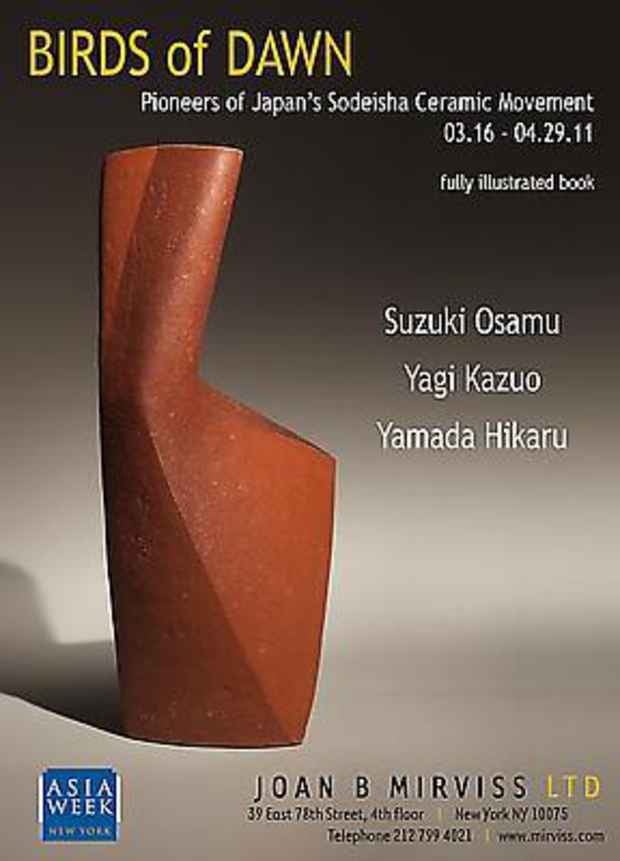"Birds of Dawn: Pioneers of Japan's Sôdeisha Ceramic Movement" Exhibition
Joan B Mirviss LTD

This event has ended.
Mirviss will present more than sixty works by this Kyoto triumvirate. Over ten years in the making, this exhibition will focus on these three seminal founders of this extremely influential movement that promoted an avant-garde approach favoring sculptural ceramics that were completely non-traditional and often bear poetic titles. Following on the heels of the war, with scant resources available, artists drew together to establish their own exhibition systems that gave them both freedom and a vehicle for artistic dialogue. These artists drew their name, Sôdeisha, literally, “Crawling Through the Mud Association,” derived from a Chinese ceramic glazing term, to express their complete absorption with their medium and its inherent limitations.
Their initial manifesto read:
“The birds of dawn taking flight out of the forest of falsehood now discover their reflections only in the spring of truth. We are united not to provide ‘a warm bed of dreams’ but to come to terms with our existence in broad daylight.”
Taken from the Sôdeisha manifesto as quoted by Louise Cort in, Isamu Noguchi and Modern Japanese Ceramists—a close embrace of the earth (Arthur M. Sackler Gallery, Smithsonian, 2003), p. 157.
Breaking free from traditional ceramics (the ‘warm bed’), these artists also looked to poetry, music, surrealism, cubism, ancient art forms, and western literature for points of departure. Influenced by diverse European artists such as Juan Miró, Paul Klee, Constantin Brancusi and Pablo Picasso, they created work that they termed “objets” but that had clear links to Japanese culture. Unlike sculptors or painters, they viewed their medium, clay, as the founding element in the creation of a work of art that also demanded finely honed techniques and processes, while enabling them to explore a wide range of themes and forms.
With the impoverished conditions present in postwar Kyoto, in order to survive these artists initially created functional vessels, often using Chinese Cizhou ware for glazing inspirations; however, while utilitarian, they stand as highly original sculptural vessels today. By the mid 1950s, the Sôdeisha artists were able to adjust their focus to purely non-functional work. As early as 1951, their work was shown in Paris, at the Musée Cernuschi together with that of numerous other Japanese ceramists and had a significant impact on the European audience of the time. Work by Yagi Kazuô was being acquired by savvy Americans as early as 1950 and by 1962 had entered the collection of the Museum of Modern Art.
The central and galvanizing figure in the development of the Sôdeisha group, which was only disbanded in 1994, was unquestionably Yagi Kazuô (1918-79), in part, because he was a voluminous author of articles for various periodicals and never afraid to challenge popular conception. His work reflects the same passion and zeal as it evolved through the decades into evocative sculptures using a large array of techniques.
With a long career, the impact of the art of Suzuki Osamu (1926-2001) was substantial as both artist and professor at Kyoto City University of Arts. His sculptural work conveys a sense of primitivism, monumentality and modernity. Although he also worked in porcelain, it is his stoneware forms made from Shigaraki clay covered with a red iron-slip glaze that are best known and collected by museums globally.
Yamada Hikaru (1923-2001), using a multiplicity of glazes and shapes, focused on perforated flat forms allowing the viewer to see through work, creating a “borrowed landscape.” Also an inspirational teacher, at Osaka Art University, he sought to deconstruct the vessel in a wide variety of approaches, rendering them as two-dimensional representations.
Today the pioneering approach and avant-garde aesthetic of these three men remains as highly influential as they were sixty years ago. There will be a fully illustrated book accompanying the exhibition with scholarly essays by Joe Earle, Rupert Faulkner and Glenn Adamson. Earle is currently Vice President and Director of the Gallery at Japan Society, and previously was Chair of the Museum of Fine Art, Boston’s Department of Art of Asia, Oceania and Africa and head of the Victoria & Albert Museum’s Asian Department where he spearheaded the creation of the Toshiba Gallery of Japanese Art. Earle has authored, translated or edited more than a dozen books and catalogues on Japanese art topics; recently in conjunction with an exhibition at the MFA and Japan Society, he wrote “Contemporary Clay: Japanese Ceramics for the New Century.” Rupert Faulkner is senior curator of the Asian Department of the Victoria & Albert Museum and author of numerous articles and publications on Japanese art of the nineteenth and twentieth centuries. Glenn Adamson currently serves as Head of Graduate Studies and Deputy Head of Research at the Victoria & Albert Museum. He has written essays for museum exhibition catalogues and has published articles and reviews in numerous journals and magazines. He is co-founder and editor of the triennial Journal of Modern Craft.
Media
Schedule
from March 16, 2011 to April 29, 2011
Artist(s)
Suzuki Osamu, Yagi Kazuo, Yamada Hikaru et al.